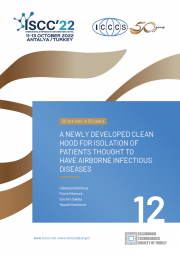A NEWLY DEVELOPED CLEAN HOOD FOR ISOLATION OF PATIENTS THOUGHT TO HAVE AIRBORNE INFECTIOUS DISEASES
Authors:
Hidekazu Nishimura, Fumie Kitamura, Soichiro Sakata, Yasushi KamimuraKeywords:
clean hood, isolation, isolation room, infectious, disease, airborneAbstract:
A new medical clean hood was developed for isolation of patients thought to have airborne diseases, such as pandemic influenza and the like. The hood is intended to be used in a ward where many patients aretreated simultaneously in the same closed airspace such as a dialysis facility, in order to prevent cross infection of other patients by the potentially infected patient. The hood consists of foldaway framework, a
fan High Efficiency Particulate Air Filter (HEPA) unit, and transparent polypropylene curtains. The patient is treated inside the hood, and airborne microbes from coughing or sneezing by the patient are contained
inside the hood, and the air containing microbes finally passes through the fan HEPA unit to be released outside the hood as clean air.
Article:
1. Introduction
The Sendai Medical Center and Takasago Thermal Engineering Co., Ltd. jointly developed the Barrihood clean booth for protecting patients in a room from infection by other patients in the same room who are
thought to be infected with a new strain of influenza during an epidemic. This booth can be used to isolate individual patients. This paper presents an outline of the technology.
2. Purpose of Development
In winter, hospitals are often required to accommodate influenza patients, even if only temporarily. However, if for example a patient 1s urgently hospitalized with influenza during the night or a holiday and
must be accommodated in a general ward because a private room is not available, or in a dialysis treatment facility with several beds, there 1s a high risk of infecting surrounding patients.
In this research, we developed a simple negative pressure hood with the aim of preventing the spread of influenza by airborne particles from coughing and so on by influenza patients who are accommodated in a
ward with other uninfected patients. (Figures 1 and 2)
3. The Behavior of Human Cough Particles
The particles generated when humans cough are a few microns in size, and their behavior is exactly the same as the air current resulting from exhaled breath. However, visualizing and analyzing these behaviors
is very difficult. Therefore we substituted these particles with the sub micron particles of cigarette smoke

 Click to Download PDF
Click to Download PDF
